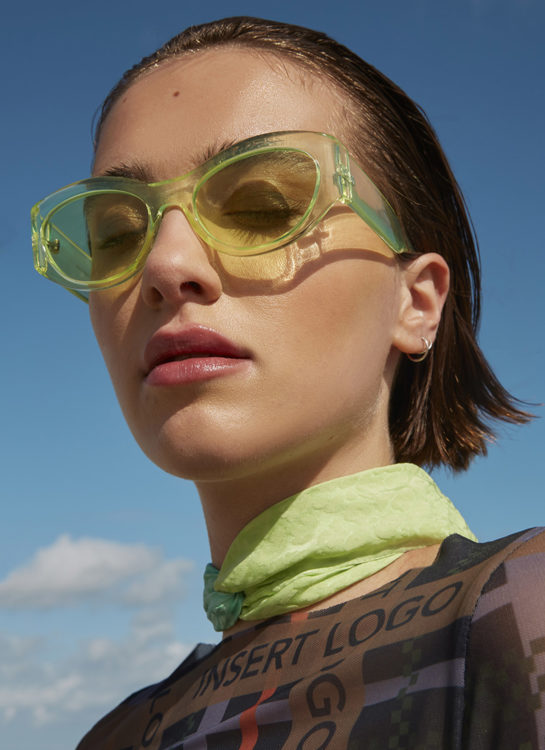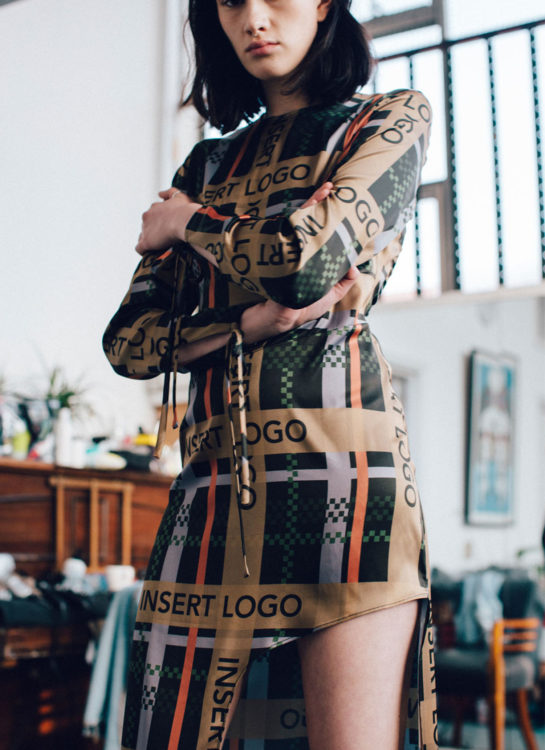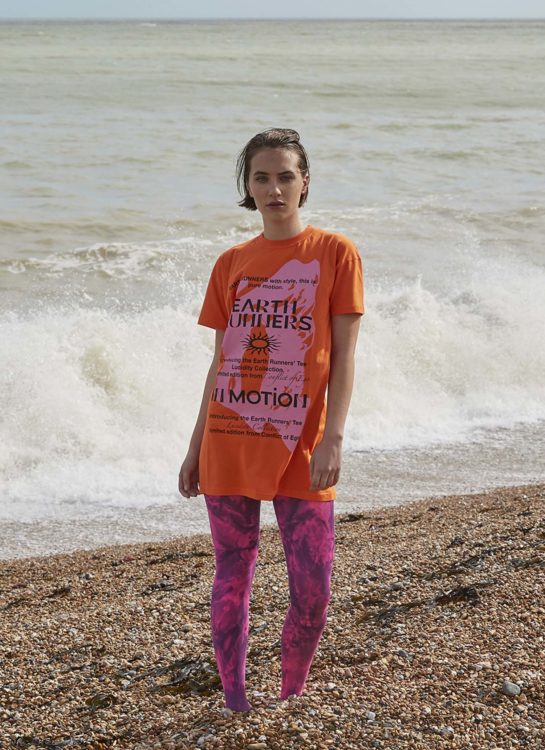- Words Solly Warner
Designed to empower, CONFLICT of EGO is a modern clothing brand fuelled by sexuality, socio-political conversations, and the slow fashion movement.


This is Pushing Fashion Forward, a new interview series championing unique talents within the rising world of sustainable fashion. Whether it’s a small team running an independent brand or a young creative upcycling old material in their bedroom, we want to show how small businesses can offer so much more than their fast fashion counterparts, encouraging a realistic approach to sustainable style.
Founded in 2016 by British designer Alanna Wain, CONFLICT of EGO is built on an identity of celebrating unity. Inspired by socio-political discussions such as the worship people show towards social media status, the struggles of trying to break into the fashion industry, and the growth of a multi-racial and diverse world, COE focuses on supporting one another throughout various industries in the Art and Design world; it’s an embodiment of a message and a mood.
COE truly feels like a brand of today and it is their youthful mindset which plays a huge role in this. Today’s youth is more informed and opinionated than ever before. Disregarding harmful traditions of the fashion industry, this progressive generation is embracing a more sustainable philosophy, showing a grown interest in reducing consumption and waste, as opposed to buying new all the time. COE is a brand that fully follows this mantra.
Alongside seasonless production, COE supports the slow fashion movement by producing collections only when Alanna is creatively inspired and is also committed to lowering their carbon footprint with recycled fabrics. With a priority on quality, Alanna wants to make pieces that will last and will be worn again and again, “we want our silks to be hanging in a Vintage store one day.” This all adds to COE’s fundamental ethical standpoints; using sustainable materials, upcycling old garments, and working on a made to order basis to create one-of-kind new pieces.
Off the back of her own struggles with finding support from major industry players, supporting and empowering other creatives has become a hugely important part of how Alanna and COE works. Some of their collaborations include the ‘Self-Love Series’ with feminist artist, Alexa Piqué, where they produced liberating and body-positive illustrations of the female form, and the ‘ONE-OF-ONE’ collection with Charlotte Rose Kirkham in which they challenged waste culture.
Through vibrant colour palettes, an array of stylistic inspirations and reworked elements, COE represents a fluid and rebellious nature. All partnered with a dedication to social and ethical responsibility, it’s a brand forged for the new generation.
Notion spoke with Alanna to discuss what she has been able to learn through collaboration, why COE is not just a brand, and how to tackle a realistic approach to sustainable fashion.



What are some of your earliest fashion memories growing up and how did that obsession begin?
Growing up I was always very sporty, so I opted for the latest sports brands and accessories to wear at the local running track where I trained a few times a week. I remember getting very excited about the Adidas and Kappa popper tracksuit bottoms which came completely off. This was a big trend when I was at high school. But I’d say my passion and experimental fashion days really started when I was 16. I got my first Saturday job and met a group of cool girls who were a bit older than me. They were totally into fashion, and we use to go out and coordinate our outfits. We spent all our money and the whole week sourcing the weekends outfits.
Where does the name CONFLICT of EGO stem from and how does it influence the brand as a whole?
Conflict of Ego is all about the ever-evolving self. The notion that ‘We’ as people grow, develop, and change over time. The ‘Ego’ can be conflicting during this journey, so I wanted to create a brand which is versatile, timeless, quality, and inclusive. When I started COE, I really struggled to find clothing which was unique, good quality and not over produced. Nobody wants to make an entrance and see someone else in the same room wearing the same garment. This is one the reasons why we avoid direct repeats and keep each release exclusive. I like to think of the styles as collectors’ items.
The brand has a clear awareness of socio-political movements. When and how did this desire to represent such topics begin for you personally?
I’ve never been the type of person to just follow the crowd and try to fit in. My personal identity and being true to myself has always been important to me. From a young age I was always very opinionated and questioned everything often falling out with like-minded family members. I suppose you could say it’s my personality and COE is a reflection of my deeper, inner thoughts. I like to think COE is more of a platform and not just a brand. Somewhere we can create art, seek meaning and demonstrate new ideas of how to live.


What challenges did you face when leaving education and how did your first body of work come to be?
The path I took wasn’t a ‘conventional path’, so I had to work my ass off and be very patient. Often making up for past decisions along the way. But I was always open to try and listen, I believe this really helped me to get to where I am now. Every job I did I learnt something; I was like a sponge soaking up everything around me. As a result, I have great intuition which gives me the ability to evolve. Something which is important in this industry. We seem to reinvent ourselves with every new project and collection. Looking back at our first collection this was very much an experimental project, testing out new ideas, fabrics, and ways of dressing. I wanted to push the boundaries on athleisure and test if luxury fabrics such as silk could be worn casually.
Why is collaboration important to you and can you tell us about your favourite partnership to date?
Collaborations are great fun! I’ve always been interested in creating hybrid garments. The idea of infusing non likely fabrics, design ideas and techniques together to produce something beautiful and unique. I find them very inspiring, and people love them. I still get excited when I see people style and wear our garments. To me this is the real reward and the true measure of success. Seeing people feel good and be happy in what you create. I think maybe the Niamh Foster collaboration has been my favourite so far, as I personally love the Halo Tie Top. It’s so beautiful and timeless.


You have also dipped your toe into the world of upcycling, such as in the ‘ONE-OF-ONE’ collection with Rua Carlota. How did this collection differ from previous collaborations?
We first started upcycling in our Spring 2018 ‘Not In Vain’ collection. Mainly using left over silk satin from our silk gowns to make small accessories like scarves, eye masks and scrunchies. This coincided with me being pregnant and having my daughter River. For me becoming a mother made me instinctively more aware and concerned about the world I was one day leaving behind for her. I totally re-evaluated the business and my lifestyle. We decided to stop making seasonal collections, instead we merged prints across collections to make them timeless, relaunched previous styles from our archives and made use out of every failed sample and swatch of fabric.
This is how the Rua Carlota collab was born. We’d never re-worked full garments to give them a new lease of life, this collaboration gave us a new perspective on upcycling and how to make use out of every resource within the business.
As someone who makes 1 of 1, made to order and upcycled pieces, why is reducing waste and promoting sustainability an important part of your fashion ideal?
For me having a more sustainable approach to business is a reflection of the times we are living in. The planet needs our help, I think it’s difficult to be aware of what’s going on and to not make active changes. We are all responsible and have a duty of care. At COE we offer an alternative to fast fashion which is ultimately kinder to our planet.


What other practices do you currently carry out to lower your carbon footprint and how are you looking to further develop and improve these practices going forward?
At the moment it’s mainly done during the design and development process, we work closely with our factories so we can improve our material mix so they contain more recycled fibres. We’ve also switched all our packaging and stationary to recycled materials.
Are you thankful that you have been able to evolve your brand during a new generation of progressive young people? What are the benefits of having these types of customers?
Yes, so thankful and it’s all happening very organically. Our hope is that we can retain the young customers we have gained and evolve together. We’re lucky to have a wide age range of customers and this is something I’m mindful of when making decisions about design, collaborators, and photo shoots. We also plan to launch more unisex and lifestyle products in the near future.
For those looking to make positive changes to their consumption, why should people support slow fashion and more transparent brands?
I think it’s about finding a balance; I’d be a total hypocrite if I said people should only support slow fashion and transparent brands. There’s a lot of good independent brands who might not be fully sustainable in their approach to fashion, but you can guarantee they’ll have great quality offering people a lower cost per wear (cost of an item divided by the number of times you wear it). Keeping this calculation in mind can help people to consume less, which will cut down on waste and reduce fast fashion purchasing. Naturally I think brands are becoming more transparent with their working methods, but this needs to be a given and not a trend.

